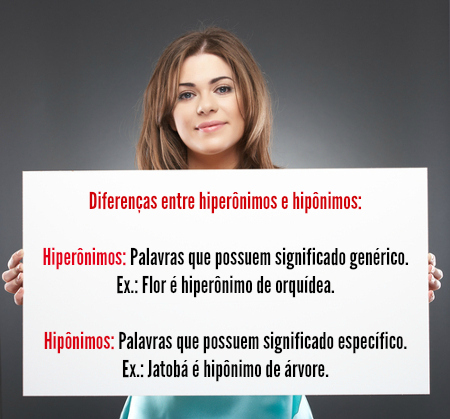The Portuguese language is so rich that we are not always able to know all its grammatical details. For example, do you know what they are hyperonyms and hyponyms? If you don't know, learn now with another Portuguese super tip that will show you the countless significant possibilities of words. Come on?
Hyperonyms and hyponyms are studied by Semantics, an area of Linguistics that deals with the study of the meaning of words. Semantics analyzes the relationship between signifiers, such as words, phrases, signs and symbols, investigating their denotation. Now that we know that these two elements are related to this branch of linguistics, it's time to understand the differences between hyperonyms and hyponyms.
► Hyperonyms: from the greek hyperonym (hyper = above, over/ onymon = name), are words with a generic sense, that is, words whose meanings are broader than the hyponyms. Making a comparison with Biology, we can say that hyperonyms would be genders, that is, words that have common characteristics. Look at the examples:
Animals is a hyperonym of dog and horse.
Vegetable is a hyperonym of potato and carrot.
Galaxy is a hyperonym of stars and planets.
Tool is a hyperonym of screwdriver and pliers.
Disease is a hyperonym of chickenpox and bronchitis.

Hyperonyms can be related to the genus, while hyponyms can be associated with the species, thus establishing the notion of hierarchy.
► Hyponyms: from the greek hyponymon (hypo = under, under/ onymon = name), are words with a specific meaning, that is, words whose meanings are hierarchically more specific than others. Making a comparison again with Biology and its terms, the hyponyms would be the species, that is, words that are linked through their own characteristics. Let's look at some examples that will certainly help you understand this issue a little better:
apple and strawberry are hyponyms of fruit.
Red and green are hyponyms of color.
Broccoli and Cauliflower are hyponyms of greenery.
flowers and trees are hyponyms of flora.
flu and pneumonia are hyponyms of disease.
Do not stop now... There's more after the advertising ;)
If you have difficulty remembering the function of each of the elements studied now, just remember the etymology of the words: the prefix hyper is associated with the idea of excess, while the prefix hippo is related to the idea of scarcity. In addition to being important for Semantics, hyperonyms and hyponyms are intrinsically related to textual cohesion, this is because they are important elements for the return of previous ideas in a text, thus avoiding the unnecessary repetition of ideas and expressions. Hyperonyms and hyponyms are words that belong to the same semantic field and, therefore, can play an anaphoric function in a text. Watch:
carnations, daisies, begonias, hydrangeas and lilies were planted by Mom in the garden. In less than a year, with the arrival of spring, all flowers broke up.
Flores is hyperonymous with carnations, daisies, begonias, hydrangeas and lilies. The term was used to avoid repetition of the hyponyms.
By Luana Castro
Graduated in Letters
Would you like to reference this text in a school or academic work? Look:
PEREZ, Luana Castro Alves. "Hyperonyms and Hyponyms"; Brazil School. Available in: https://brasilescola.uol.com.br/gramatica/hiponimos-hiperonimos.htm. Accessed on June 27, 2021.
